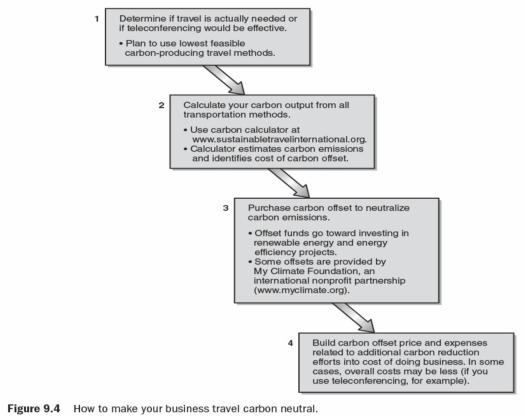Common green practices lead to sustainability for RET providers
This is an excerpt from Recreation, Event, and Tourism Businesses With Web Resources by Robert Pfister & Patrick Tierney.
Four increasingly common "go green" business practices are described here, including resources for obtaining additional information. These can all be elements of an RET company's efforts toward triple bottom line accounting and sustainability.
- Green your building. The design and operation of a building can have a large impact on the health of the occupants inside and the outside environment, as well as on operational costs. So there is a strong push toward making buildings greener. The best-known green building certification system is the Leadership in Energy and Environmental Design (LEED) Green Building Certification and Rating System, which encourages and accelerates global adoption of sustainable green building and development practices. The LEED certification is designed to guide and distinguish high-performance commercial and institutional projects, including office buildings and recreation facilities. It measures and encourages use of sustainable sites and transportation, promotes water efficiency, optimizes energy performance, encourages renewable energy, protects natural resources, reduces construction waste and encourages reuse, minimizes resource consumption, discourages reliance on toxics, and improves indoor air quality. The process can be used by even small RET businesses. See the LEED Web site (www.usgbc.org/DisplayPage.aspx?CategoryID=19) for more details.
- Leave no trace. For many years, ecotourism tour outfitters have tried to minimize their impacts on the natural environment and other users. Now there is a comprehensive system designed to inform both professional guides and individual wild land users on ways to plan ahead and prepare; travel and camp on durable surfaces; dispose of waste properly; leave what you find; minimize campfire impacts; respect wildlife; and be considerate of other visitors. The Leave No Trace Center for Outdoor Ethics has training available for company employees at reasonable rates. See www.LNT.org for more details.
-
Operate carbon neutral. There has been a strong new trend toward assessing environmental impacts before implementation and then determining ways to reduce nonrenewable energy use, carbon dioxide emissions, and unsustainable resource use. Companies are designing green buildings, airlines are reducing carbon output from jets, and small companies are switching to biodiesel fuel and hybrid cars. Alpine Meadows resort, awarded top listing in the California Ski Area Environmental Scorecard, is 100 percent wind powered. More companies are attempting to be carbon neutral (not contributing a net gain in carbon dioxide to the atmosphere through their travel or events) by reducing carbon dioxide emissions to the extent possible and then including the expense of carbon offsets in their cost of doing business. Carbon offsets are payments made to finance new renewable energy sources and planting of carbon-absorbing trees that counterbalance carbon emissions from travel. For ways to make your travel more sustainable, see www.sustainabletravelinternational.org and figure 9.4. Another similar alternative that can be used to offset carbon dioxide production from operations is to purchase renewable energy credits (RECs) that allow you to buy renewable wind power-generated electricity. Using this method, the Stratton, Vermont, and Alpine Meadows ski resorts are 100 percent wind powered. If your company is not adopting these technologies and practices, then you may be losing employees and customers who expect you to be a leader-and a loss of customers translates to a loss of profits. These actions may still be the right thing to do, even if there are no direct immediate financial rewards.

- Green your event. The trend is clear: Demand for greener events is growing. The examples are numerous, from mega-events such as the 2006 Olympics in Turin, Italy, 2010 Winter Olumpics in Whistler, British Columbia, and a "carbon neutral" Rolling Stones concert to smaller local events, such as environmentally friendly meetings and weddings (Davidson, 2007). Your company can plan the program or hire a growing number of event planners who specialize in green events. Some basic considerations for greening your event include sending electronic invitations rather than paper, using biodegradable plastic tableware, featuring live plants as part of the decor, serving condiments in bulk containers instead of individual packets, booking your event at an eco-certified hotel, using green power, and featuring sustainable seafood in meals. For additional details on making your event greener, see www.itsyournature.org/files/NRDC-GREENGUIDE-FINAL_0.pdf.
SHOP

Get the latest insights with regular newsletters, plus periodic product information and special insider offers.
JOIN NOW
Latest Posts
- Authenticity was key to McKinney’s NIL success
- AI—A new tool for sport PR pros
- Essential skills for sport PR practitioners
- Employ these tactics when pitching a story to the media
- How does ergonomic analysis and intervention enhance safety and reduce injury risk?
- Common movement patterns in competitive cycling


